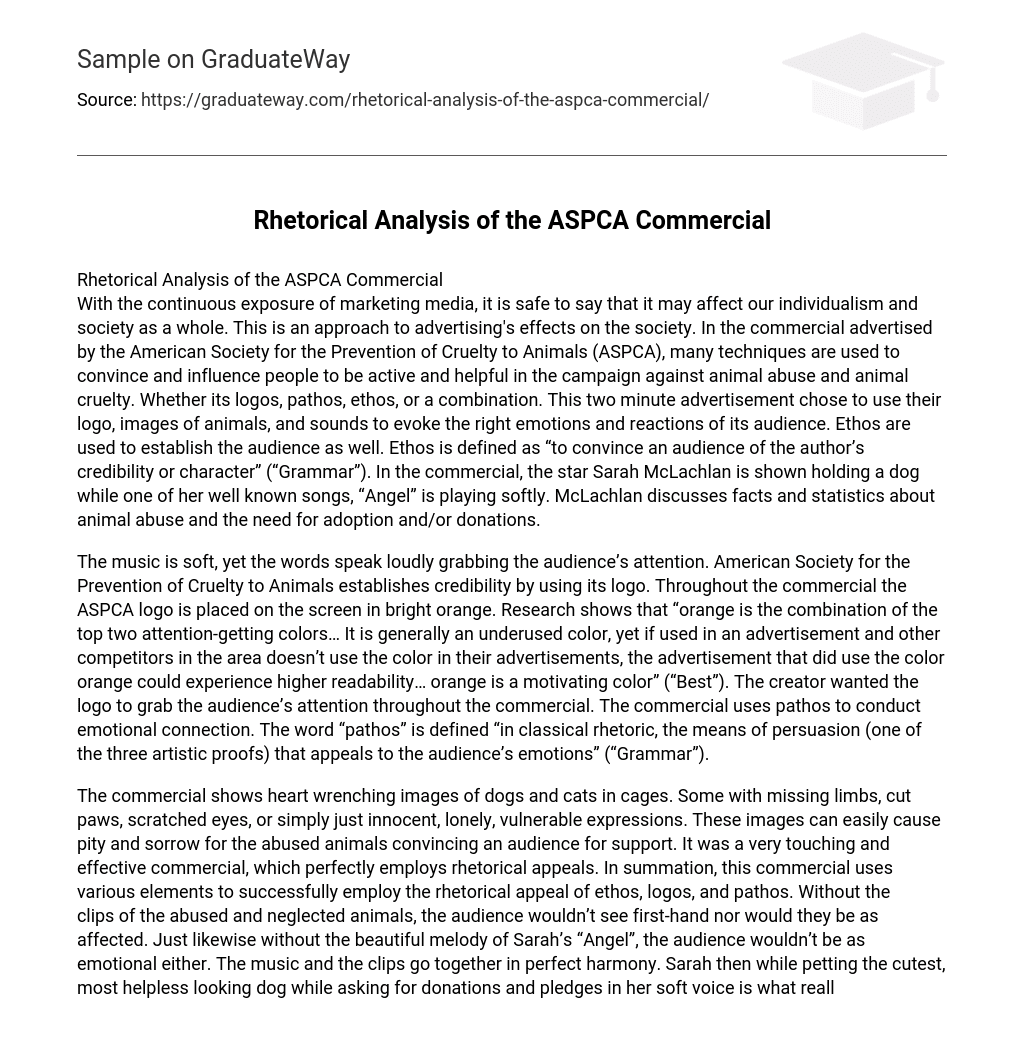With the continuous exposure of marketing media, it is safe to say that it may affect our individualism and society as a whole. This is an approach to advertising’s effects on the society. In the commercial advertised by the American Society for the Prevention of Cruelty to Animals (ASPCA), many techniques are used to convince and influence people to be active and helpful in the campaign against animal abuse and animal cruelty.
Whether its logos, pathos, ethos, or a combination. This two minute advertisement chose to use their logo, images of animals, and sounds to evoke the right emotions and reactions of its audience. Ethos are used to establish the audience as well. Ethos is defined as “to convince an audience of the author’s credibility or character” (“Grammar”). In the commercial, the star Sarah McLachlan is shown holding a dog while one of her well known songs, “Angel” is playing softly. McLachlan discusses facts and statistics about animal abuse and the need for adoption and/or donations.
The music is soft, yet the words speak loudly grabbing the audience’s attention. American Society for the Prevention of Cruelty to Animals establishes credibility by using its logo. Throughout the commercial the ASPCA logo is placed on the screen in bright orange. Research shows that “orange is the combination of the top two attention-getting colors… It is generally an underused color, yet if used in an advertisement and other competitors in the area doesn’t use the color in their advertisements, the advertisement that did use the color orange could experience higher readability… orange is a motivating color” (“Best”).
The creator wanted the logo to grab the audience’s attention throughout the commercial. The commercial uses pathos to conduct emotional connection. The word “pathos” is defined “in classical rhetoric, the means of persuasion (one of the three artistic proofs) that appeals to the audience’s emotions” (“Grammar”).
The commercial shows heart wrenching images of dogs and cats in cages. Some with missing limbs, cut paws, scratched eyes, or simply just innocent, lonely, vulnerable expressions. These images can easily cause pity and sorrow for the abused animals convincing an audience for support. It was a very touching and effective commercial, which perfectly employs rhetorical appeals. In summation, this commercial uses various elements to successfully employ the rhetorical appeal of ethos, logos, and pathos. Without the clips of the abused and neglected animals, the audience wouldn’t see first-hand nor would they be as affected. Just likewise without the beautiful melody of Sarah’s “Angel”, the audience wouldn’t be as emotional either.
The music and the clips go together in perfect harmony. Sarah then while petting the cutest, most helpless looking dog while asking for donations and pledges in her soft voice is what really sealed the deal. All these emotions of sadness, and empathy really affect the audience then successfully fulfilling the purpose of the commercial. Everything comes together which makes this commercial such a good example of various techniques used at its finest.
Works Cited
- Maudry, Shannon. “The Best Colors for Marketing Flyers to Attract People.” www.ehow.com. n.d. 28 Sept 2013.





